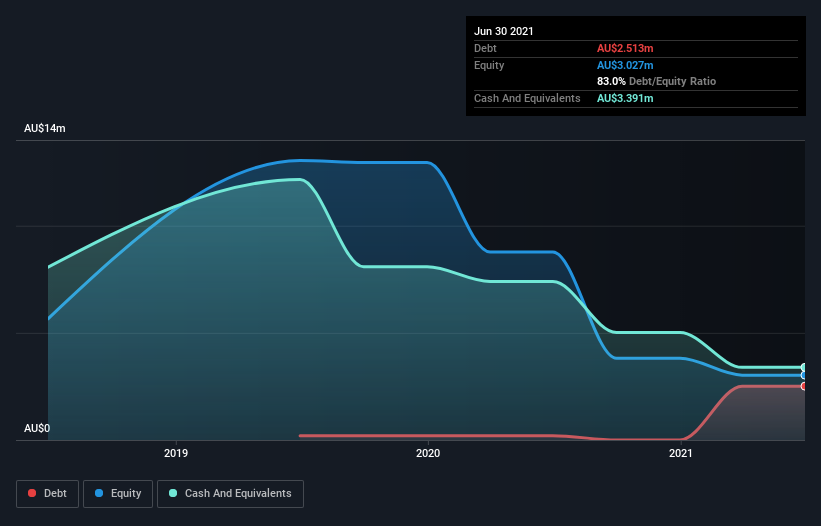Is Mediland Pharm (ASX:MPH) A Risky Investment?
Some say volatility, rather than debt, is the best way to think about risk as an investor, but Warren Buffett famously said that 'Volatility is far from synonymous with risk.' When we think about how risky a company is, we always like to look at its use of debt, since debt overload can lead to ruin. We can see that Mediland Pharm Limited (ASX:MPH) does use debt in its business. But the real question is whether this debt is making the company risky.
When Is Debt Dangerous?
Debt assists a business until the business has trouble paying it off, either with new capital or with free cash flow. Ultimately, if the company can't fulfill its legal obligations to repay debt, shareholders could walk away with nothing. However, a more common (but still painful) scenario is that it has to raise new equity capital at a low price, thus permanently diluting shareholders. Having said that, the most common situation is where a company manages its debt reasonably well - and to its own advantage. The first thing to do when considering how much debt a business uses is to look at its cash and debt together.
See our latest analysis for Mediland Pharm
What Is Mediland Pharm's Debt?
You can click the graphic below for the historical numbers, but it shows that as of June 2021 Mediland Pharm had AU$2.51m of debt, an increase on AU$198.0k, over one year. However, it does have AU$3.39m in cash offsetting this, leading to net cash of AU$878.3k.
How Healthy Is Mediland Pharm's Balance Sheet?
We can see from the most recent balance sheet that Mediland Pharm had liabilities of AU$2.58m falling due within a year, and liabilities of AU$4.18m due beyond that. On the other hand, it had cash of AU$3.39m and AU$377.1k worth of receivables due within a year. So its liabilities total AU$2.99m more than the combination of its cash and short-term receivables.
Since publicly traded Mediland Pharm shares are worth a total of AU$21.6m, it seems unlikely that this level of liabilities would be a major threat. But there are sufficient liabilities that we would certainly recommend shareholders continue to monitor the balance sheet, going forward. Despite its noteworthy liabilities, Mediland Pharm boasts net cash, so it's fair to say it does not have a heavy debt load! There's no doubt that we learn most about debt from the balance sheet. But it is Mediland Pharm's earnings that will influence how the balance sheet holds up in the future. So when considering debt, it's definitely worth looking at the earnings trend. Click here for an interactive snapshot.
Over 12 months, Mediland Pharm made a loss at the EBIT level, and saw its revenue drop to AU$1.2m, which is a fall of 95%. To be frank that doesn't bode well.
So How Risky Is Mediland Pharm?
We have no doubt that loss making companies are, in general, riskier than profitable ones. And the fact is that over the last twelve months Mediland Pharm lost money at the earnings before interest and tax (EBIT) line. Indeed, in that time it burnt through AU$2.3m of cash and made a loss of AU$6.3m. But the saving grace is the AU$878.3k on the balance sheet. That kitty means the company can keep spending for growth for at least two years, at current rates. Overall, we'd say the stock is a bit risky, and we're usually very cautious until we see positive free cash flow. The balance sheet is clearly the area to focus on when you are analysing debt. But ultimately, every company can contain risks that exist outside of the balance sheet. For example, we've discovered 4 warning signs for Mediland Pharm (3 are a bit concerning!) that you should be aware of before investing here.
Of course, if you're the type of investor who prefers buying stocks without the burden of debt, then don't hesitate to discover our exclusive list of net cash growth stocks, today.
This article by Simply Wall St is general in nature. We provide commentary based on historical data and analyst forecasts only using an unbiased methodology and our articles are not intended to be financial advice. It does not constitute a recommendation to buy or sell any stock, and does not take account of your objectives, or your financial situation. We aim to bring you long-term focused analysis driven by fundamental data. Note that our analysis may not factor in the latest price-sensitive company announcements or qualitative material. Simply Wall St has no position in any stocks mentioned.
Have feedback on this article? Concerned about the content? Get in touch with us directly. Alternatively, email editorial-team (at) simplywallst.com.

 Yahoo Finance
Yahoo Finance 
